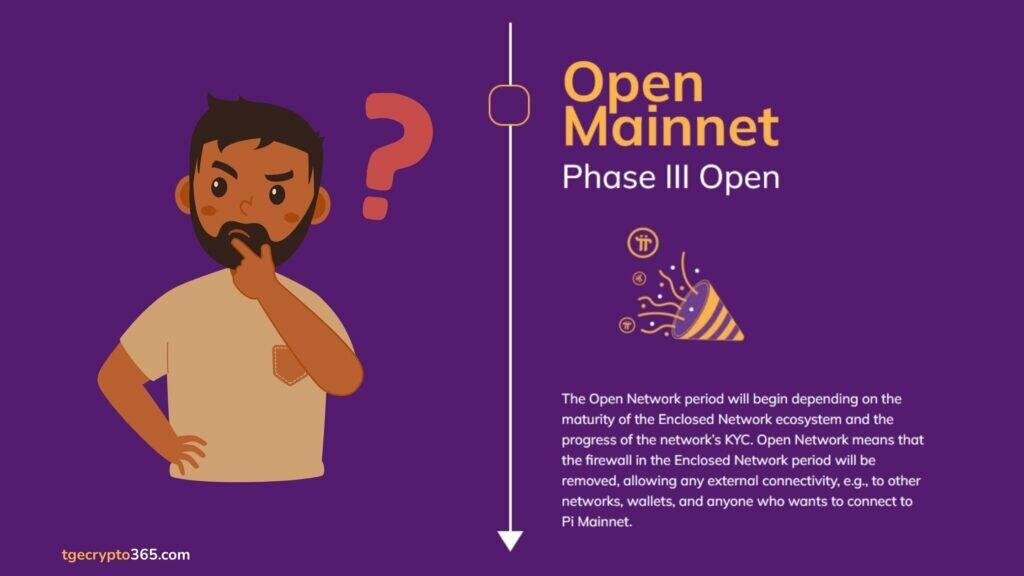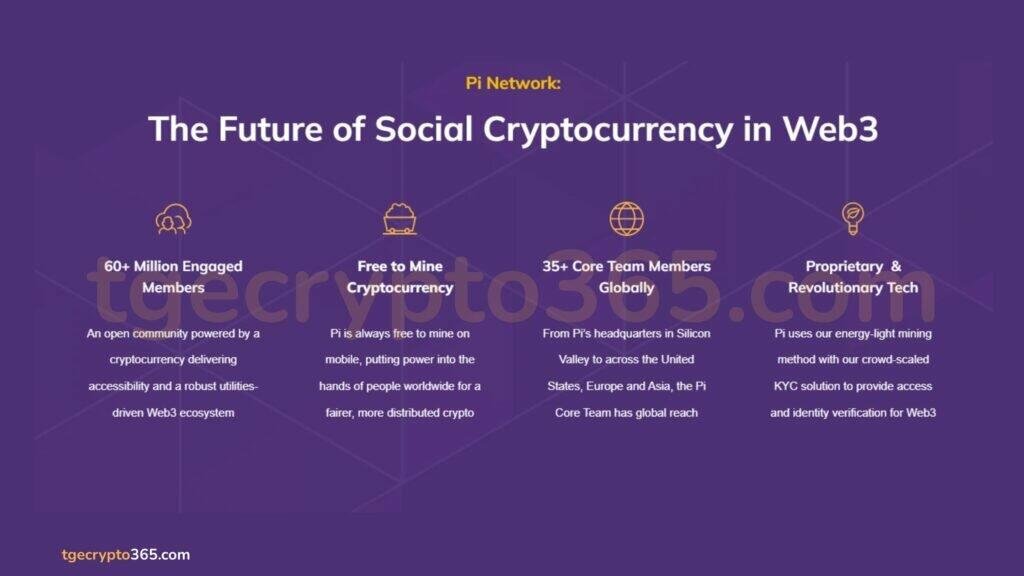Are you ready for a crypto revolution? 🚀 Brace yourself, because the Pi Network Open Mainnet launch in 2025 might just turn the cryptocurrency world on its head. As a Pioneer, you’ve been part of an extraordinary journey, mining Pi coins from your smartphone without breaking a sweat (or your electricity bill). But the real excitement is just beginning.
Imagine a world where your Pi coins aren’t just numbers on a screen, but a powerful tool for financial freedom. With the Open Mainnet launch on the horizon, you’re standing at the threshold of a new era in digital currency. But here’s the burning question: Are you prepared for what’s coming? From transferring coins to external wallets to trading on major exchanges, the opportunities are endless – and so are the challenges.
In this post, we’ll guide you through the Pi Network Open Mainnet journey, unpack the significance of the Open Mainnet launch, and reveal the key features that set Pi apart. You’ll discover how to prepare for this monumental transition, explore the ecosystem’s potential, and learn critical considerations every Pioneer needs to know. Get ready to dive deep into the future of Pi Network and how it could reshape the crypto landscape in 2025. 🌟
Understanding Pi Network Open Mainnet
A. Stanford-led digital currency initiative
You might be surprised to learn that Pi Network’s journey began at one of the world’s leading universities. Dr. Nicolas Kokkalis and Dr. Chengdiao Fan, both Stanford PhDs, founded Pi Network in 2018. Their goal? To make cryptocurrency accessible to everyone.
Dr. Kokkalis, the Head of Technology, brings his expertise in distributed systems and human-computer interaction to the project. He even taught Stanford’s first decentralized applications course in 2018. Dr. Fan, the Head of Product, focuses on using social computing to enhance human potential globally.
B. Mobile app-based mining approach
Pi Network’s innovative approach sets it apart from other cryptocurrencies. Here’s how:
- Mobile-first strategy
- User-friendly interface
- Accessible mining process
By allowing you to mine Pi coins through a mobile app, the network removes the need for expensive hardware or technical knowledge. This democratizes access to cryptocurrency, aligning with the founders’ vision of inclusivity.
C. Network expansion and community engagement
Pi Network’s growth has been impressive, thanks to its community-centric approach. The project encourages global participation and rewards contributions, creating an inclusive ecosystem. Here’s a snapshot of Pi Network’s engagement strategy:
| Strategy | Purpose |
|---|---|
| Community rewards | Incentivize participation |
| Social media presence | Keep users informed and engaged |
| Blog and Medium articles | Share in-depth information and updates |
D. Development phases: Beta, Testnet, Enclosed mainnet
Your journey with Pi Network follows a carefully planned development roadmap:
- Beta phase: Initial testing and user onboarding
- Testnet: Rigorous blockchain testing
- Enclosed mainnet: Transition to an independent blockchain
The network has successfully moved from the Testnet to the Enclosed mainnet, marking a significant milestone. This transition demonstrates Pi Network’s readiness for mainstream use and its ability to operate independently.
With this understanding of Pi Network Open Mainnet, you’re now ready to explore the significance of the Open Mainnet launch. This next phase could potentially revolutionize how you interact with cryptocurrencies and blockchain technology.
The Significance of Pi Network Open Mainnet Launch
A. Scheduled for February 20, 2025
Now that we have explored Pi Network Open Mainnet, let’s focus on the significant milestone ahead: the Open Mainnet launch. Scheduled for February 20, 2025, this event marks a crucial transition for the Pi ecosystem. You’ll witness the network moving from its current enclosed state to a fully operational, open blockchain environment.
B. Enabling external wallet transfers and exchange listings
With the Pi Network Open Mainnet launch, you’ll gain the ability to transfer your Pi coins to external wallets and potentially trade them on cryptocurrency exchanges. This development opens up new possibilities for you as a Pioneer:
- External transfers: Move your Pi coins beyond the network’s ecosystem
- Exchange listings: Trade Pi on various cryptocurrency platforms
- Increased liquidity: Easier buying and selling of Pi coins
C. Facilitating decentralized application (DApp) development
The Open Mainnet will significantly boost the development of decentralized applications within the Pi ecosystem. As a Pioneer, you’ll have access to:
| DApp Features | Benefits for You |
|---|---|
| Increased functionality | More ways to use your Pi coins |
| Diverse ecosystem | Greater variety of services and applications |
| Community-driven innovation | Participate in creating and using new DApps |
D. Potential impact on market dynamics and Pi coin value
The transition to Open Mainnet could have a substantial effect on Pi’s market dynamics and value. You should be aware of the following potential outcomes:
- Increased market excitement and speculation
- Potential price volatility as trading becomes unrestricted
- Greater accessibility leading to wider adoption
It’s important to note that while some IOU trading has reflected prices between $61 and $70, these are speculative and not indicative of Pi’s actual market value post-launch.
With this significant milestone on the horizon, you’ll want to prepare for the opportunities and challenges that come with an open network. Next, we’ll explore the key features of Pi Network that make it unique in the cryptocurrency landscape.
Key Features of Pi Network
Now that we’ve explored the significance of Pi Network’s open mainnet launch, let’s delve into the key features that make this cryptocurrency platform unique. These features are crucial to understanding how Pi Network could potentially change the crypto landscape in 2025.
Federated Byzantine Agreement (FBA) Algorithm
You’ll find that Pi Network utilizes the Stellar Consensus Protocol (SCP), which is based on the Federated Byzantine Agreement algorithm. This innovative approach sets Pi apart from traditional cryptocurrencies:
- Energy-efficient: Unlike Bitcoin’s energy-intensive Proof-of-Work system, FBA consumes minimal power.
- Environmentally friendly: The reduced energy consumption aligns with global demands for sustainable practices.
- Democratized mining: FBA allows for mining without specialized hardware, making it accessible to a broader audience.
Daily Mining Through Mobile App
One of Pi Network’s most distinguishing features is its mobile-friendly mining process:
- Smartphone-based: You can mine Pi directly from your mobile device.
- User-friendly interface: The app is designed for ease of use, requiring just a daily login and button click.
- No upfront costs: Mining Pi doesn’t require expensive equipment or technical expertise.
This accessibility is particularly appealing if you’re in regions lacking conventional mining infrastructure.
Security Circles and Referral System
Pi Network employs a unique trust-based model to enhance security and foster community growth:
| Feature | Benefit |
|---|---|
| Security Circles | Mitigate fraud and bot activity |
| User Vouching | Enhance network authenticity |
| Referral System | Encourage community expansion |
By forming security circles, you’re actively contributing to the network’s integrity while building a stronger Pi community.
Integration with Fintech and E-commerce Platforms
As Pi Network evolves, you can expect to see increased integration with various platforms:
- Pi Marketplace: A dedicated space for transactions using Pi coins.
- Third-party applications: Plans to incorporate Pi into external apps and services.
- Decentralized economy: The network aims to establish a broader ecosystem for Pi usage.
These integrations are crucial for Pi’s real-world utility and could significantly impact its adoption rate.
With these key features in mind, you’re now better equipped to understand how Pi Network is positioning itself in the cryptocurrency market. Next, we’ll explore how you can prepare for the upcoming open mainnet transition, which will be pivotal in realizing Pi Network’s full potential.
Preparing for the Open Mainnet Transition
Now that we’ve explored the key features of Pi Network, let’s dive into how you can prepare for the upcoming Open Mainnet transition.
A. Completing KYC verification process
Your first step in preparing for the Open Mainnet is to complete the Know Your Customer (KYC) verification process. This crucial step ensures you’ll have access to your Pi balances post-launch. Here’s what you need to know:
- The deadline for KYC verification has been extended to February 28, 2025.
- Failure to complete KYC by this date will result in forfeiting your Pi balance, except for Pi earned in the last six months.
- Use the “Mainnet Checklist” in your Pi mining app to guide you through the process.
B. Migrating coins to open mainnet
Once you’ve completed KYC, you’ll need to migrate your Pi coins to the Mainnet. This process is essential for transitioning from the testnet to the platform that allows real-world transactions. Remember:
- Only verified users can migrate their coins.
- The migration process will be available through the Pi Network app.
- Stay informed through official channels for specific instructions on how to migrate your coins.
C. Selecting suitable exchanges for trading
While Pi Network hasn’t been listed on exchanges yet, you should prepare for potential trading opportunities:
| Exchange Type | Considerations |
|---|---|
| Centralized | – Higher liquidity<br>- Easier to use<br>- May require additional KYC |
| Decentralized | – More privacy<br>- Direct control of assets<br>- May have lower liquidity |
Keep an eye on official announcements regarding exchange listings, as this information hasn’t been confirmed yet.
D. Managing account security and market volatility
As you prepare for the Open Mainnet, prioritize your account security and be ready for potential market fluctuations:
- Enable two-factor authentication on your Pi Network account.
- Use a strong, unique password for your Pi wallet.
- Be cautious of phishing attempts and only use official Pi Network channels.
- Understand that cryptocurrency markets can be volatile, especially for new tokens.
With these preparations in mind, you’ll be well-positioned for the transition to the Open Mainnet. Next, we’ll explore the opportunities and challenges that await in Pi Network’s ecosystem as it moves towards this significant milestone.
Opportunities and Challenges in Pi Network’s Ecosystem
Now that we’ve covered how to prepare for the Open Mainnet transition, let’s explore the opportunities and challenges that await you in Pi Network’s ecosystem.
Mainnet apps and real-world transactions
As Pi Network’s Open Mainnet launches, you’ll witness a surge in decentralized applications (DApps) across various sectors. With over 100 DApps already available, you’ll find opportunities in payments, gaming, and DeFi. This growth establishes practical use cases for your Pi coins, allowing you to engage in real-world transactions.
| Sector | Examples of DApps |
|---|---|
| Payments | Pi Wallet, Pi Pay |
| Gaming | Pi Casino, Pi Adventure |
| DeFi | Pi Swap, Pi Lend |
Developer engagement through Pi Dev Portal
You’ll notice increased developer activity through the Pi Dev Portal. This platform enables easier access for developers to list their applications on the Pi Browser. As a result, you can expect:
- A wider variety of apps to choose from
- Improved quality and compliance standards
- Enhanced utility for your Pi coins
Potential for innovative financial applications
The introduction of .pi domains opens up new possibilities for you:
- Secure customized domain names for your business or personal branding
- Participate in the .pi Domain Auction platform
- Engage in e-commerce and brand identity within the Pi ecosystem
These domains function within a Web3 environment, integrating with the Pi Browser and blockchain technology to ensure secure and transparent transactions.
Security concerns and lack of oversight for independent apps
While the ecosystem grows, you should be aware of potential challenges:
- Lack of centralized oversight for independent apps
- Potential security risks in newly developed applications
- Volatility in Pi’s market value
| Aspect | Potential Risk |
|---|---|
| App Security | Vulnerabilities in new, untested apps |
| Market Volatility | Price fluctuations affecting Pi’s value |
| Regulatory Compliance | Evolving legal landscape for cryptocurrencies |
As you navigate these opportunities and challenges, it’s crucial to stay informed and cautious. In the next section, we’ll delve into critical considerations for Pioneers like yourself, helping you make the most of your Pi Network experience.
Critical Considerations for Pioneers
Now that we’ve explored the opportunities and challenges in Pi Network’s ecosystem, let’s delve into some critical considerations for Pioneers as we approach the potential open mainnet launch in 2025.
A. Speculative nature of current Pi coin valuations
As a Pioneer, you should be aware that the current valuations of Pi coins are highly speculative. With the coin remaining unlisted and practically worthless as of November 2024, it’s crucial to approach any predictions with caution. Price projections for Pi vary wildly:
| Year | Low Estimate | High Estimate |
|---|---|---|
| 2030 | $0.08 | $577+ |
Remember, these figures are based on speculation and not concrete market data. Your expectations should be tempered by the fact that Pi’s actual value will be determined by market demand and the success of its ecosystem post-launch.
B. Liquidity and accessibility improvements
You’ll likely see significant improvements in liquidity and accessibility as Pi transitions to an open network. However, be prepared for potential challenges:
- Initial trading may be limited
- Selling pressure from early miners could affect prices
- Liquidity issues might arise in the early stages of open trading
C. Centralization and privacy concerns
As you participate in the Pi Network, consider these aspects:
- KYC verification: Over 12 million users completed this by mid-2024, but it’s a requirement for transferring mined coins.
- Network structure: Pi uses the Stellar Consensus Protocol, which differs from Bitcoin’s proof of work.
- Privacy: Your data is used to build trust circles, which are integral to the network’s security.
To protect yourself in this evolving landscape:
- Stay informed about the launch conditions
- Be cautious of speculative trading strategies
- Understand the tokenomics and how they might affect coin value
- Consider the competition from established cryptocurrencies
- Evaluate the development of real-world applications within the Pi ecosystem
Remember, while Pi Network aims to democratize cryptocurrency mining, its success depends on factors like user engagement, successful transition to an open network, and the growth of its app ecosystem. Your participation as a Pioneer is crucial, but always approach it with a balanced view of the potential rewards and risks.
As Pi Network approaches its open mainnet launch in 2025, you stand at the cusp of a potential revolution in the cryptocurrency landscape. This transition promises to unlock new opportunities for Pioneers, enabling external wallet transfers, exchange listings, and the development of decentralized applications. However, it’s crucial to approach this milestone with both excitement and caution.
To make the most of this transformative phase, ensure you complete your KYC verification and prepare for the migration of your coins to the open mainnet. Stay informed about the evolving ecosystem, including the rollout of Mainnet apps and the potential risks associated with increased accessibility. While the future of Pi Network remains uncertain, your active participation and vigilance can help shape a more inclusive and innovative digital financial era. As you navigate this new frontier, remember that your engagement as a Pioneer contributes to the network’s growth and potential success in redefining cryptocurrency adoption.
Frequently Asked Questions (FAQs):
-
Q: What is the Pi Network open mainnet?
A: The Pi Network open mainnet is the fully operational blockchain network where Pi cryptocurrency can be transferred and used in real-world transactions.
-
Q: When did the Pi Network open mainnet launch?
A: The Pi Network open mainnet launched on December 28, 2022.
-
Q: How does the open mainnet differ from the closed mainnet?
A: The open mainnet allows Pi coins to be freely transferred between users and used for transactions, while the closed mainnet had limited functionality and restricted transfers.
-
Q: Can I transfer my Pi coins to other users now?
A: Yes, with the open mainnet, you can transfer Pi coins to other verified users within the network.
-
Q: How do I verify my account for the open mainnet?
A: To verify your account, complete the KYC (Know Your Customer) process within the Pi Network app.
-
Q: Are there any fees for transactions on the Pi Network open mainnet?
A: The Pi Network uses a minimal fee structure for transactions to prevent spam and maintain network security.
-
Q: Can I exchange Pi coins for other cryptocurrencies or fiat money?
A: Currently, Pi coins are not available on major cryptocurrency exchanges. The ability to exchange Pi for other currencies may develop as the network grows.
-
Q: What can I do with my Pi coins on the open mainnet?
A: You can transfer Pi coins to other users, participate in the Pi ecosystem, and potentially use them for purchases as more merchants adopt the currency.
-
Q: Is my Pi balance from the mining app automatically available on the open mainnet?
A: Not automatically. You need to complete the account verification process to migrate your balance to the open mainnet.
-
Q: How secure is the Pi Network open mainnet?
A: The Pi Network uses blockchain technology and consensus mechanisms to ensure security. However, as with any digital currency, users should follow best practices for protecting their accounts.
Disclaimer:
I am not a Financial Advisor. This content is for informational purposes only. Always consult a qualified professional before making financial decisions.











Наведение порядка в СПб! Избавьтесь от забот, доверьтесь профессионалам! Сделайте шаг к чистоте уже сегодня Переходите Клининг
[…] ready to unlock the potential of blockchain technology as we guide you through user interfaces, supported networks, security measures, and much […]